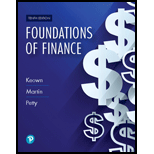
Foundations Of Finance
10th Edition
ISBN: 9780134897264
Author: KEOWN, Arthur J., Martin, John D., PETTY, J. William
Publisher: Pearson,
expand_more
expand_more
format_list_bulleted
Concept explainers
Textbook Question
Chapter 15, Problem 14SP
(Cost of factoring) MDM, Inc. is considering factoring its receivables. The firm has credit sales of $400,000 per month and has an average receivables balance of $800,000 with 60-day credit terms.
The factor has offered to extend credit equal to 90 percent of the receivables factored less interest on the loan at the rate of 1.5 percent per month. The 10 percent difference in the advance and the face value of all receivables factored consists of a 1 percent factoring fee plus a 9 percent reserve, which the factor maintains. In addition, if MDM, Inc. decides to factor its receivables, it will sell them all so that it can reduce its credit department costs by $1,500 a month.
- a. What is the cost of borrowing the maximum amount of credit available to MDM, Inc. through the factoring agreement?
- b. What considerations other than cost should MDM, Inc. account for in determining whether to enter the factoring agreement?
Expert Solution & Answer
Want to see the full answer?
Check out a sample textbook solution
Students have asked these similar questions
Dome Metals has credit sales of $288,000 yearly with credit terms of net 120 days, which is also the average collection period. Assume the firm adopts new credit terms of 3/18, net 120 and all customers pay on the last day of the discount period. Any reduction in accounts receivable will be used to reduce the firm's bank loan which costs 10 percent. The new credit terms will increase sales by 15% because the 3% discount will make the firm's price competitive.
a. If Dome earns 20 percent on sales before discounts, what will be the net change in income if the new credit terms are adopted? (Use a 360-day year.)
b. Should the firm offer the discount?
Taylor Glass has annual sales of $1,790,000. Although it extends credit for 30 days (n30), the receivables are 20 days overdue. What is the average accounts receivable outstanding, and how much could the company save in interest expense if customers paid on time and if it costs Taylor Glass 9 percent to carry its receivables? Assume 360 days in a year. Round your answers to the nearest cent.
Accounts receivable: $
Interest saved: $
Chapter 15 Solutions
Foundations Of Finance
Ch. 15 - Dell Computer Corporation (DELL) has long been...Ch. 15 - Prob. 2RQCh. 15 - Prob. 3RQCh. 15 - Prob. 4RQCh. 15 - Explain what is meant by the statement The use of...Ch. 15 - Prob. 6RQCh. 15 - Prob. 7RQCh. 15 - How can the formula interest = principle rate ...Ch. 15 - How can we accommodate the effects of compounding...Ch. 15 - Prob. 10RQ
Ch. 15 - Prob. 11RQCh. 15 - Prob. 12RQCh. 15 - Prob. 1SPCh. 15 - Prob. 2SPCh. 15 - Prob. 3SPCh. 15 - (Estimating the cost of bank credit) Paymaster...Ch. 15 - (Cost of short-term financing) The R. Morin...Ch. 15 - (Cost of secured short-term credit) The Marlow...Ch. 15 - (Cost of short-term financing) You plan to borrow...Ch. 15 - Prob. 8SPCh. 15 - (Cost of trade credit) Calculate the effective...Ch. 15 - (Annual percentage yield) Compute the cost of the...Ch. 15 - Prob. 11SPCh. 15 - (Cost of accounts receivable) The Michelin...Ch. 15 - (Cost of accounts receivable) The Michelin...Ch. 15 - (Cost of factoring) MDM, Inc. is considering...Ch. 15 - (Cost of factoring) A factor has agreed to lend...Ch. 15 - Prob. 16SPCh. 15 - Prob. 17SP
Knowledge Booster
Learn more about
Need a deep-dive on the concept behind this application? Look no further. Learn more about this topic, finance and related others by exploring similar questions and additional content below.Recommended textbooks for you
 EBK CONTEMPORARY FINANCIAL MANAGEMENTFinanceISBN:9781337514835Author:MOYERPublisher:CENGAGE LEARNING - CONSIGNMENT
EBK CONTEMPORARY FINANCIAL MANAGEMENTFinanceISBN:9781337514835Author:MOYERPublisher:CENGAGE LEARNING - CONSIGNMENT
 Intermediate Financial Management (MindTap Course...FinanceISBN:9781337395083Author:Eugene F. Brigham, Phillip R. DavesPublisher:Cengage Learning
Intermediate Financial Management (MindTap Course...FinanceISBN:9781337395083Author:Eugene F. Brigham, Phillip R. DavesPublisher:Cengage Learning

EBK CONTEMPORARY FINANCIAL MANAGEMENT
Finance
ISBN:9781337514835
Author:MOYER
Publisher:CENGAGE LEARNING - CONSIGNMENT


Intermediate Financial Management (MindTap Course...
Finance
ISBN:9781337395083
Author:Eugene F. Brigham, Phillip R. Daves
Publisher:Cengage Learning


Cost-Volume-Profit (CVP) Analysis and Break-Even Analysis Step-by-Step, by Mike Werner; Author: Accounting Step by Step;https://www.youtube.com/watch?v=D0MOfse9OWk;License: Standard Youtube License